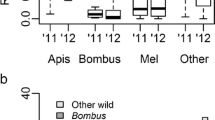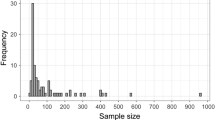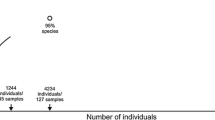Abstract
Xylocopa species are large solitary bees, which are effective pollinators of yellow passion fruit, a self-incompatible crop dependent on pollination for fruit production and economic viability. We tested the mark–recapture method to estimate these bees' population size in a passion fruit commercial orchard in Central Brazil. We collected data during 3 years and population was estimated as 118, 339, and 1,032 individuals. Population size and abundance of Xylocopa bees were higher in the last studied year. These bees maintained 32.5 % of natural fruit set, above economic viability levels, and higher than other commercial orchards, although population size showed no direct correlation with natural fruit set. Improvement of nesting site may explain population increase, reinforcing the importance of management. Our results showed that the mark–recapture technique can provide reliable estimates of Xylocopa bees population size and, thus, be useful in monitoring population trends.



Similar content being viewed by others
References
Bischoff, I. (2003) Population dynamics of the solitary digger bee Andrena vaga Panzer (Hymenoptera, Andrenidae) studied using mark–recapture and nest counts. Popul. Ecol. 45(3), 197–204
Camillo, E. (2003) Polinização de maracujá. Holos Editora, Ribeirão Preto
Camillo, E., Garófalo, C.A. (1982) On the bionomics of Xylocopa frontalis (Oliver) and Xylocopa grisescens (Lepeletier) in Southern Brazil. I—Nest construction and biological cycle. Rev. Bras. Biol. 42(3), 571–582
Camillo, E., Garófalo, C.A. (1989) Social organization in reactivated nests of three species of Xylocopa (Hymenoptera, Anthophoridae) in southeastern Brasil. Insect. Soc. 36(2), 92–105
Camillo, E., Garófalo, C.A., Muccillo, G. (1986) On the bionomics of Xylocopa suspecta (Moure) in Southern Brazil: nest construction and biological cycle (Hymenoptera, Anthophoridae). Rev. Bras. Biol. 46(2), 383–393
Cavalcanti, R.B., Joly, A.C. (2002) Biodiversity and conservation priorities in the Cerrado region. In: Oliveira, P.S., Marquis, R.J. (eds.) The Cerrados of Brazil: ecology and natural history of a neotropical savanna, pp. 351–367. Columbia University Press, New York
Chaves-Alves, T.M., Junqueira, C.N., Rabelo, L.S., Oliveira, P.E.A.M., Augusto, S.C. (2011) Recursos ecologicos utilizados por las especies de Xylocopa (Hymenoptera, Apidae) en el área urbana. Rev. Colomb. Entomol. 37(2), 313–317
Freitas, B.M., Oliveira-Filho, J.H. (2001) Criação racional de mamangavas para polinização em áreas agrícolas. Banco do Nordeste, Fortaleza
Gerling, D., Velthuis, H.H.W., Hefetz, A. (1989) Bionomics of the large carpenter bees of the genus Xylocopa. Annu. Rev. Entomol. 34, 163–190
Haddad, N.M., Hudgens, B., Damiani, C., Gross, K., Kuefler, D., Pollock, K. (2008) Determining optimal population monitoring for rare butterflies. Conserv. Biol. 22(4), 929–940
Hurd, P.J. (1978) An annotated catalog of the carpenter bees (Genus Xylocopa) of the Western Hemisphere (Hymenoptera: Anthophoridae). Smithsonian Institution Press, Washington
Jamieson, I.J., Forbes, M.R., McKnight, E.B. (2000) Mark–recapture study of mountain stone weta Hemideina maori (Orthoptera: Anostostomatidae) on rock tor ‘islands’. New Zeal. J. Ecol. 24, 209–214
Junqueira, C.N., Hogendoorn, K., Augusto, S.C. (2012) The use of trap-nests to manage carpenter bees (Hymenoptera: Apidae: Xylocopini), pollinators of passion fruit (Passifloraceae: Passiflora edulis f. flavicarpa). Ann. Entomol. Soc. Am. 105(6), 884–889
Kavati, R. (1998) Florescimento e frutificação do maracujazeiro amarelo (Passiflora edulis f flavicarpa). In: Ruggiero, C. (ed.) Maracujá do plantio à colheita, pp. 107–129. Funep, Jaboticabal
Klink, C.A., Moreira, A.G. (2002) Past and current human occupation, and land use. In: Oliveira, P.S., Marquis, R.J. (eds.) The Cerrados of Brazil: ecology and natural history of a neotropical savanna, pp. 69–88. Columbia University Press, Washington
Krebs, C.J. (1989) Ecological methodology. Harper Collins, New York
Kunin, W.E. (1997) Population size and density effects in pollination: pollinator foraging and plant reproductive success in experimental arrays of Brassica kaber. J. Ecol. 85(2), 225–234
Larsson, M., Franzén, M. (2008) Estimating the population size of specialized solitary bees. Ecol. Entomol. 33(2), 232–238
Lettink, M., Armstrong, D.P. (2003) An introduction to using mark–recapture analysis for monitoring threatened species. Dep. Conserv. Tech. Ser. 28A, 5–32
Liberato, J.R., Costa, H. (2001) Doenças fúngicas, bacterianas e fitonematóides. In: Bruckner, C.H., Picanço, M.C. (eds.) Maracujá tecnologia de produção, pós-colheita, agroindústria, mercado, pp. 243–282. Editora Cinco Continentes, Porto Alegre
Melo, G.A.R., Varassin, I.G., Vieira, A.O.S., Menezes, A.O., Löwenberg-Neto, P., et al. (2005) Polinizadores de maracujás no Paraná. Subprojeto 02.02.89. Relatório Técnico. PROBIO Edital 02/2003 – Uso sustentável e restauração da diversidade de polinizadores autóctones na agricultura e nos ecossistemas associados. Curitiba, PR.
Mesquita, T.M.S., Augusto, S.C. (2011) Diversity of trap-nesting bees and their natural enemies in the Brazilian savanna. Trop. Zool. 24(2), 127–144
Michener, C.D. (2000) The bees of the world. The John Hopkins University Press, Baltimore
Myers, N., Mittermeier, R.A., Mittermeier, C.G., Fonseca, G.A.B., Kent, J. (2000) Biodiversity hotspots for conservation priorities. Nature 403, 853–858
National Research Council of the National Academies (2007) Status of Pollinators in North America. National Academies Press, Washington, D.C. http://books.nap.edu/catalog.php?record_id=11761
Neto, P.L. (2008) Levantamento planimétrico n° 36.243, Prefeitura de Uberlândia, Minas Gerais
O'Toole, C., Raw, A. (1991) Bees of the world. Blandford, London
Oliveira-Filho, J.H., Freitas, B.M. (2003) Colonização e biologia reprodutiva de mamangavas (Xylocopa frontalis) em um modelo de ninho racional. Cienc. Rural. 33(4), 693–697
Pereira, M., Garófalo, C.A. (2010) Biologia da nidificação de Xylocopa frontalis e Xylocopa grisescens (Hymenoptera, Apidae, Xylocopini) em ninhos-armadilha. Oecol. Aust. 14(1), 193–209
Potts, S.G., Biesmeijer, J.C., Kremen, C., Neumann, P., Schweiger, O., Kunin, W.E. (2010) Global pollinator declines: trends, impacts and drivers. Trends Ecol. Evol. 25(6), 345–353
Ramalho, M., Batista, M.A., Silva, M. (2004) Xylocopa (Monoxylocopa) abbreviata Hurd & Moure (Hymenoptera: Apidae) e Encholirium spectabile (Bromeliaceae): uma associação estreita no semi-árido do Brasil tropical. Neotropical Entomol. 33(4), 417–425
Rosa, R., Lima, S.C., Assunção, W.L. (1991) Abordagem preliminar das condições climáticas de Uberlândia (MG). Soc. Nat. 3(5–6), 91–108
Roulston, T.H., Goodell, K. (2011) The role of resources and risks in regulating bee populations. Annu. Rev. Entomol. 56, 293–312
Silva, J.R. (2005) A cultura do maracujazeiro (Passiflora edulis Sims. f. flavicarpa Deg.) na Região do Triângulo Mineiro. Aspectos práticos, Relatório técnico
Silveira, F.A., Melo, G.A.R., Almeida, E.A.B. (2002) Abelhas Brasileiras: Sistemática e Identificação. MMA, Fundação Araucária, Belo Horizonte
Siqueira, K.M.M., Kill, L.H.P., Feitosa, C.M., Lemos, I.B., Monteiro, S.P., Feitosa, E.A. (2009) Ecologia da polinização do maracujá-amarelo, na região do vale do submédio São Francisco. Rev. Bras. Frutic. 31(1), 1–12
Steffan-Dewenter, I., Schiele, S. (2004) Nest-site fidelity, body weight and population size of the red mason bee, Osmia rufa (Hymenoptera: Megachilidae), evaluated by mark–recapture experiments. Entomol. Gen. 27(2), 123–132
Vaissière, B.E., Freitas, B.M., Gemmil-Heren, B. (2011) Protocol to detect and assess pollination deficits in crops: a handbook for its use. Food and Agriculture Organization of the United Nation, Rome
Yamamoto, M., Silva, C.I., Augusto, S.C., Barbosa, A.A.A., Oliveira, P.E. (2012) The role of bee diversity in pollination and fruit set of yellow passion fruit (Passiflora edulis forma flavicarpa, Passifloraceae) crop in Central Brazil. Apidologie 43(5), 515–526
Acknowledgments
We are thankful to J.C. Santos for valuable suggestions, to P.E.F Alvarenga, T.M. Chaves-Alves, H.L. Pedroso, and O.H.P. Armondes for help in data collection. Thanks are also due to R.F. Freitas, C.T. Santos, G.R.O. Freitas; H. Grande; J.Z. Júnior; M.R. Tavares; N.G. Bordon; N.A.S. Filho; R.A.S. Molina for helping us in field activities in 2007. Financial support came from PROBIO/Pollinator/Brazil Environment Ministry (Grant 0112-00/2005), and FAPEMIG—Research Support Foundation of Minas Gerais (Grants CRA-2037/05, APQ-01755/2009, and grants for the first author CRA-PDJ 0187/09 and CRA-BPD 0132-11).
Author information
Authors and Affiliations
Corresponding author
Additional information
Manuscript editor: Klaus Hartfelder
Estimation de la population de pollinisateurs de fruits de la passion par l’utilisation de la méthode de capture–recapture
Savanne brésilienne / abeille charpentière / méthode de Jolly–Seber / Passiflora edulis f. flavicarpa / Xylocopa
Schätzung der Bestäuberpopulation für Passionsfrucht mittels einer Markierungs-Wiederfang-Methode
Brasilianische Savanne / Jolly–Seber Methode / Passiflora edulis f. flavicarpa / Xylocopa
Rights and permissions
About this article
Cite this article
Yamamoto, M., Junqueira, C.N., Barbosa, A.A.A. et al. Estimating crop pollinator population using mark–recapture method. Apidologie 45, 205–214 (2014). https://doi.org/10.1007/s13592-013-0238-1
Received:
Revised:
Accepted:
Published:
Issue Date:
DOI: https://doi.org/10.1007/s13592-013-0238-1




